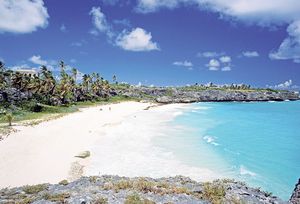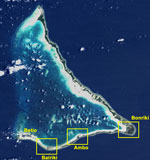
“We are facing the end of history. We don’t want to be the sacrificed countries of the 21st century. We want to survive.” These were the words of Antonio Lima, ambassador of Cape Verde to the UN, speaking at the start of the Cancún conference, where he is one of the delegates representing the 43 members of the Alliance of Small Island States (AOSIS).
They’re heartfelt words. They’re also knowing. The realities of climate change at this early stage are much closer to some countries than to others. Small island states are among them. Hot Topic has drawn attention to some of the most threatened such as Kiribati, the Maldives, and Tuvalu. To them can be added most of the Cook Islands and the Marshall Islands as nations which Lima said will be washed away by sea level rise (SLR).
The effect of SLR on Caribbean islands will be less total but a new report nevertheless reveals highly alarming prospects. Commissioned by the United Nations Development Programme, the UK’s Department for International Development and the Organisation of Eastern Caribbean States, the report has been produced by Caribsave, a partnership between the Caribbean Community Climate Change Centre and the University of Oxford. There’s an excellent survey in this week’s Independent, written by the environment editor Michael McCarthy. The report itself is accompanied by a convenient publication which provides the key points and a summary for policy makers.
It carefully analyses the impacts of a one metre SLR this century. They include the loss of nearly 1300 km2 of land, the displacement of over 110,000 people, damage to or loss of at least 149 multi-million dollar tourism resorts, beach assets lost or greatly degraded at many more resorts, and the severe disruption of transportation networks. Severe storms would exacerbate these effects, as would the coastal erosion which will accompany SLR. The study also details the even worse impacts of a 2 metre SLR, which many scientists now consider cannot be ruled out.
The likely costs of adaptation are detailed in the report. Suffice to say here that they rise to very large percentages of GDP by the end of the century. The figures are staggering for developing countries.
AOSIS makes two pleas to the developed world. The first is not to accept a 2 degree rise in global temperature as safe for humanity. 1.5 degrees is the maximum we should settle for. They are not on their own with such a claim. Indeed where the science is concerned it is becoming increasingly clear that 2 degrees cannot be considered a safe limit. As Kevin Anderson and Alice Bows put it in their recent paper published in the Philosophical Transactions of the Royal Society, “the impacts associated with 2◦C have been revised upwards, sufficiently so that 2◦C now more appropriately represents the threshold between ‘dangerous’ and ‘extremely dangerous’ climate change.”
I’ll briefly detour to note that Anderson’s and Bow’s paper, Beyond ‘dangerous’ climate change: emission scenarios for a new world, is one in a series in a Theme Issue of the Philosophical Transactions which considers the probability and consequences of a warming of 4 degrees or higher, as a not unlikely result if the present trajectory of emissions is not reversed more drastically than so far indicated. Their article speaks of a “pivotal disjuncture between high level aspirations and the policy reality”.
So if there’s little as yet to suggest that even the 2 degree guardrail is likely to be achieved, how much less likely is the 1.5 degrees that AOSIS pleads for? One can almost hear the “get real” response from the big guys. But AOSIS are dealing in a physical reality: ”The difference between 1.5 degrees and 2 degrees is the difference between survival and collapse,” said Lima. It may not be a political reality, but it’s hardly their task to trim the science to fit what negotiators consider politically possible.
The second plea from AOSIS is for assistance in coping with the future effects of climate change. The Telegraph reports that they are calling for a global insurance fund to be set up.
“Poor nations at risk of sea level rise would pay an annual premium, but a large chunk of the money would come from climate change aid provided by rich nations. Like a normal insurance fund, the money would be invested privately so that there are hundreds of billions of pounds available in the event of a crisis.
“The fund would pay out according to damage, as it is impossible to prove weather is directly caused by climate change. However the insurance would only be available to nations that are affected by global warming and do not have the capacity to protect themselves. Also they would have to first take reasonable preventative measures, such as building coastal defences, so that the money is only used for extreme events.
“The insurance pay-outs could help whole nations pay for a new ‘homeland’ if sea level rise means it becomes impossible to live on their own island. It could also be used to repair airports, roads and hotels.”
The plea for assistance should not fall on such deaf ears as the plea for mitigation action is likely to. The Copenhagen Accord agreed that developed countries will support the implementation of adaptation action in developing countries, and that such funding “will be prioritized for the most vulnerable developing countries, such as the least developed countries, small island developing States and Africa.”
The closer we draw to the unfolding effects of global warming the more apparent it becomes that the costs of adapting to it will stretch our economic capacity. Beyond breaking point in the case of some developing countries if they do not receive assistance. Reports such as that on the Caribbean will be invaluable in identifying with more precision the adaptation needs in specific regions and prompting the preparations which simple prudence demands. They may also serve to jolt us into more serious endeavours to cut emissions. We don’t have to construct such a dangerous future.


 I’d like to return briefly to the fate of Kiribati as sea levels rise, following up my recent
I’d like to return briefly to the fate of Kiribati as sea levels rise, following up my recent 